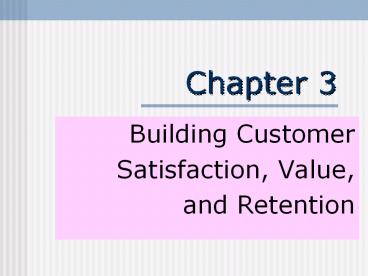Building Customer - PowerPoint PPT Presentation
1 / 24
Title:
Building Customer
Description:
Chapter 3 Building Customer Satisfaction, Value, and Retention Defining Values and Satisfaction Customer Delivered Value = difference between total customer value and ... – PowerPoint PPT presentation
Number of Views:55
Avg rating:3.0/5.0
Title: Building Customer
1
Chapter 3
- Building Customer
- Satisfaction, Value,
- and Retention
2
Defining Values and Satisfaction
- Customer Delivered Value difference between
total customer value and total customer cost - Satisfaction persons feelings of pleasure or
disappointment resulting from comparing a
products perceived performance in relation to
his/her expectations.
3
Customer Delivered Value
- Total customer value
- Product value
- Service value
- Personnel value
- Image value
- Total customer cost
- Monetary cost
- Time cost
- Energy cost
- Psychic cost (Cognitive dissonance)
4
Implications of customer value analysis
- The customer can use value-price ratios to
compare offers. - The seller knows where he ranks in the buyers
mind. - Assumption Customers will buy from whoever
offers the highest delivered value
5
Does this model (assumption) work in reality?
- Not all the time as
- Customer is locked by contract.
- Customer adheres to cheaper price
- L-T relations with other suppliers
6
Customer Satisfaction
- Perceived performance VS Expectation
- Expectation is based on past buying experience,
friends advice, marketers and competitors
information and promises.
7
Tools for Tracking and Measuring Satisfaction
- Complaint and suggestion systems e.g. MK Suki
- Customer satisfaction surveys
- Ghost Shopping e.g. Chesters Grill
- Lost customer analysis (Exit interviews, Customer
loss rate)
8
Delivering Customer Value and Satisfaction
- Value chain
- Core business processes include
- - Market sensing
- - New product realization
- - Customer acquisition
- - Customer Relationship Management (CRM)
- - Fulfillment management
- Value-delivery networkvalue chains of
stakeholders
9
Attracting and Retaining Customers
- Is the cost of attracting a new customer higher
than the cost of retaining a customer?
Statistically, the cost of attracting a new
customer is estimated to be 5 times the cost of
keeping a current customer happy.
10
Attracting and Retaining Customers (2)
- Attracting customers
- Importance of customer retention
- Retaining Computing the cost of lost customers
- Measuring Customer Lifetime Value
- Relationship marketing
11
Attracting and Retaining Customers (3)
- Attracting customers harder than b4
- Importance of customer retention
- Highly satisfied customer buys more of the
companys product. - He/she carries good word-of-mouth.
- He/she pays less attention to competing brands.
- He/she costs less to serve than new cust.
12
Retaining Computing the cost of lost customers
- Easy way to calculate the cost of lost customers
is on pp.73. - 4 steps to reduce the cost of lost customers.
- 1st Define and measure the retention rate
- 2nd Distinguish the causes of customer attrition
and identify the customers that can be managed
better
13
Retaining Computing the cost of lost customers
(2)
- 4 steps to reduce
- 3rd Estimate how much profit the company loses
when it loses customers - Customer Lifetime Value (CLV) the present value
of the profit stream that the company would have
realized on a customer had not defected
prematurely.
14
Retaining Computing the cost of lost customers
(3)
- 4 steps to reduce
- 4th figure out how much it would cost to reduce
the defection rate - Cost lt lost profit, adopt the plan
Measuring CLV
- Read pp.75-76
15
Relationship Marketing
Suspects
Prospects
1st-time customers
Repeat Custs
Clients
Advo
Prtnrs
Disqualified prospects
Inactive or Ex-customers
16
5 Levels in Customer-Relationship Building
- Basic marketing transactional marketing
- Reactive marketing customer activates sales
- Accountable marketing company activates sales
- Proactive marketing company foresees what
customer wants - Partnership marketing company and customer work
2gether to achieve the best result for both
17
Questions???
- If a companys profit margin is small, and the
company has many customers what level of
customer-relationship building should be adopted
by this company?
18
3 Customer Value-Building Approaches
- Adding financial benefits
- Frequency marketing program (FMPs) e.g. Thai
Airway's mileage cards, DTACs points, Citibanks
monthly points - Club Marketing e.g. Lancomes membership cards,
Dokyas membership cards
19
3 Customer Value-Building Approaches (2)
- Adding Social Benefits to recognize the name and
wants of each individual customer/client - e.g. Pizza Hut tries to personalize service
- Adding Structural Ties to force customers to
repeat purchase - e.g. providing special equipment
20
Customer Profitability
- A profitable customer is a person, household, or
company that over time yields a revenue stream
that exceeds by an acceptable amount the
companys to attract them.
21
Customer Profitability (2)
- 20/80 rule the top 20 of the customers may
generate as much as 80 of the companys profits - 20/80/30 rule the top 20 of customers generate
80 of the company profits, half of which are
lost serving the bottom 30 of unprofitable
customers - Implication Fire the worst customers to increase
profits
22
Implementing TQM
- Total quality management (TQM) is an
organization wide approach to continuously
improving the quality of all the organizations
processes, products, and services.
23
Quality
- Quality is totality of features and
characteristics of products or service which can
satisfy customers expressed or implied needs. - 1. Performance Quality
- 2. Conformance Quality
24
To deliver high quality of products or services
- Correctly identify customers needs.
- Communicate customers need to product designers.
- Fill in the order correctly and on time.
- Check for customers correct use of the product.
- Stays in touch with customers.
- Convey product or service improvement idea to the
appropriate department.































